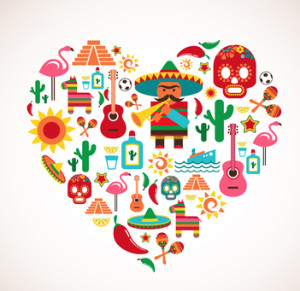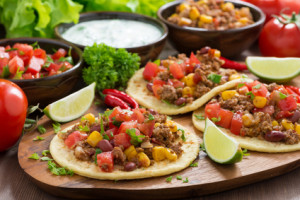 Mexico has one of the richest cultures in the world. Its traditions and customs remained steadfast until the late 19th and 20th centuries. During this time, large numbers of the population moved to cities; thus, the shift to a more modern world began. Almost half of Mexico’s population now lives in an urban setting, and as such, many of Mexico’s cities have begun to mimic the United States and England. Large cities such as Mexico City, Puebla-Tlaxcala, and Monterrey have become very contemporary in their way of life; whereas, rural areas such as Yucatan, Guerrero, and Sonora still hold fast to that small rural charm as generations before them. Although modernism has infused the many larger cities in Mexico, many of the century’s old traditions and customs can still be found. It is this overall mix of people and their lifestyles that make this country unique and fascinating.
Mexico has one of the richest cultures in the world. Its traditions and customs remained steadfast until the late 19th and 20th centuries. During this time, large numbers of the population moved to cities; thus, the shift to a more modern world began. Almost half of Mexico’s population now lives in an urban setting, and as such, many of Mexico’s cities have begun to mimic the United States and England. Large cities such as Mexico City, Puebla-Tlaxcala, and Monterrey have become very contemporary in their way of life; whereas, rural areas such as Yucatan, Guerrero, and Sonora still hold fast to that small rural charm as generations before them. Although modernism has infused the many larger cities in Mexico, many of the century’s old traditions and customs can still be found. It is this overall mix of people and their lifestyles that make this country unique and fascinating.
A Brief History of Mexico
In the 16th century it was ruled by the Spanish. In 1810 it declared its independence; however, during this time Mexico experienced much turmoil and change within its political structure. Mexico has had many presidents and several interim presidents over the last century and a half. Some of these presidents ruled for 1 year, some for 2 or 3 years, some for 14 years, and one in particular ruled for over 35 years (Porfirio Diaz). Many of these men had personal agendas and once in power exploited the country and its people. Porfirio Diaz and Plutarco Elias Calles were two of these men. There were a few noble presidents; however, that worked towards the betterment of the country. One was Lazaro Cardenas, who once entering office, began to clean house and threw out many of the corrupt officials.
With the Spanish colonizing Mexico in the 16th century, it also introduced the Catholic religion to the natives. Today it is the predominant faith practiced in Mexico. In 1917, the government began to minimize the church’s role. In 1926 through 1929, the Cristero Wars came to fruition as citizens took up arms against the government in opposition. As a result, many people died on both sides of this civil unrest, but in the end, the Catholic Church resumed its power and status. Today, the Catholic Church still continues to have great influence on the Mexican people.
There are, however, other major religions practiced in Mexico. They range anywhere from Protestant, evangelicals, to Jehovah’s Witnesses and others; although, approximately three percent of the population does not associate with any particular religion whatsoever.
Language, Art, and Literature in Mexico
Spanish is the national spoken language, but there are sixty-two other recognized languages and dialects. Today, many English words derived from the Spanish language have become part of everyday vocabulary. Some of these words are tomato, avocado, and coyote just to name a few.
The Pre-Columbian art in Mexico is derived from indigenous people, but there is also much influence from the inhabitance of the Spanish. In the time of the Mexican Revolution (1910 to about 1920) artists began to capture the historic and political turmoil of that time. In the early 20th century, European style art began to also emerge.
Literature made its way into the heart and souls of the Mexican people via its past history of indigenous settlements. Influence of the Spanish was also a major contributor to this. Some of the major authors are Alfonso Reyes, Octavio Paz, Mariano Azuela, and many more too numerous to mention.
 Celebrations, Cuisine, and Music in Mexico
Celebrations, Cuisine, and Music in Mexico
Mexicans have wonderful celebrations. These are centered on major events or things such as September 16, which is the day Mexico won their independence from the Spanish. This is celebrated with excitement and enthusiasm much like Americans celebrate the 4th of July. The Day of the Dead Festival is another great one. This is centered on paying respect to the dead and includes decorating the tombstones of family members. Another day that is celebrated is Dia de la Virgin de Guadalupe (Our Lady of Guadalupe) and is a huge affair. This holiday marks the time that the Virgin Mary appeared to the Mexican people in Hidalgo, which is a section in Mexico City.
Mexican cuisine has quickly become very popular around the world. Dishes include tacos, tamales, enchiladas, mole, atole, and many others. Some of the traditional ingredients used in Mexican cooking include potatoes, meat, beans, rice, onions, and a variety of peppers. Maize (corn) is also very common. Mexican food is known for its spicy flavor, which is usually derived by their heavy use of chili powder, various chili pods, and cumin. Almost all Mexican dishes contain some form of onion and garlic. Both ingredients are considered a staple in most dishes. Depending on the part of Mexico that you visit, you will find different foods. In communities closer to the ocean, fish will be the major dish. In other areas you may experience spicier foods. Tequila and mescal continue to be a popular drink in the country. Other popular beverages in Mexico can include flavored water, wine, beer, and juices.
Music is a universal language and Mexico has many variations within the country. Depending on the region that you visit, you may hear a certain type of music. Some of the popular known music is Mariachi, Norteno, Banda, Corridos, and Rancheras.
Migration to the United States
Because Mexico borders the United States, many Mexican’s, and others from other Latin American countries, continue to migrate to this country. Mexican cultural influences can be heavily seen in U.S. border towns as well as some of the major cities in the United States. The swell of Mexicans in large U.S. cities is mostly due to people looking for employment and a better way of life. As a result of this close proximity, first-generation Mexicans now call the United States their home.
Visiting Mexico and seeing this rich culture first hand will leave you wanting to return again. From its cuisine, its language and its people, Mexico offers a wide variety of things to witness and experience.




